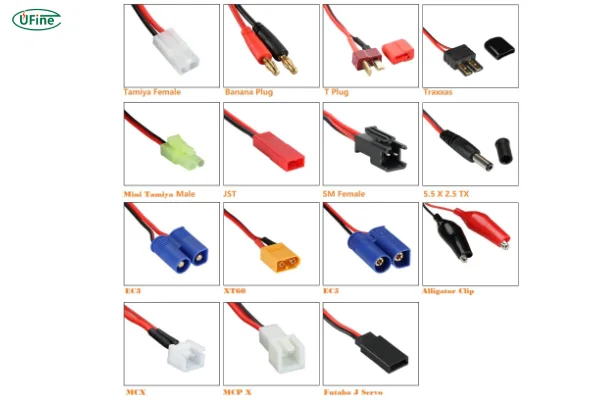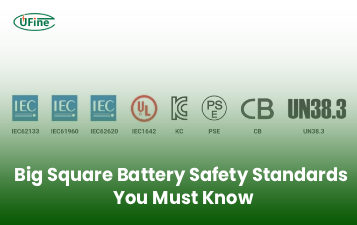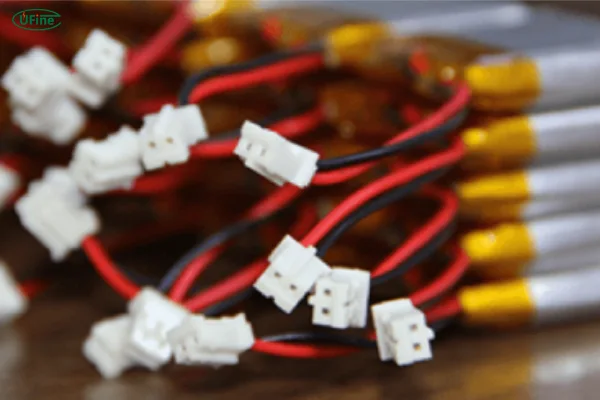
- Part 1. What are LiPo battery plugs?
- Part 2. Top 10 most common LiPo battery plug types
- Part 3. Choosing the right plug for your application
- Part 4. Compatibility and cross-adaptability
- Part 5. Soldering and installing LiPo battery plugs
- Part 6. LiPo plug safety tips
- Part 7. How to maintain and inspect your LiPo connectors
- Part 8. LiPo battery plug innovations and trends
- Part 9. Using plug adapters vs direct soldering
- Part 10. LiPo battery plugs for charging setups
- Part 12. FAQs
LiPo (Lithium Polymer) batteries have become the power source of choice for hobbyists and professionals alike in RC vehicles, drones, airsoft guns, robotics, and more. While much attention is given to battery capacity and voltage, one often-overlooked yet crucial component is the LiPo battery plug. The plug you use can affect everything from power delivery to safety and ease of use. In this guide, we’ll cover everything you need to know about LiPo battery plugs: from the different types available to how to choose, install, and maintain them.
Part 1. What are LiPo battery plugs?
LiPo battery plugs (also referred to as connectors) are the physical interface between your battery and the device it powers. They facilitate the flow of electrical current from the battery to the electronic speed controller (ESC), motor, or charger. These plugs come in various shapes, sizes, and amperage ratings, each suited to specific use cases.
Most LiPo plugs are polarized to prevent reverse polarity, and they typically consist of two main components:
- Male and Female ends: Male connectors have exposed pins, while female connectors have sockets.
- Housing and metal contacts: Designed to handle varying levels of current and minimize resistance.
Choosing the right plug is vital to ensure safe operation, optimal performance, and compatibility with your gear.
Part 2. Top 10 most common LiPo battery plug types

Here’s a breakdown of the most widely used LiPo connectors:
- XT60: Rated for 60A continuous current. Very popular in drones and RC vehicles.
- XT90: Bigger brother of XT60, handles up to 90A. Often used in high-performance RC setups.
- EC3: Rated for 60A. Known for secure fit; used in RC airplanes and helicopters.
- EC5: Larger version of EC3, can handle 120A. Used in high-current applications.
- Deans T-Plug: A classic. Compact design, good for up to 60A.
- JST (Japan Solderless Terminal): Small and lightweight. Ideal for low-current, micro applications.
- TRX (Traxxas): Proprietary connector by Traxxas, designed for their line of RC vehicles.
- HXT 4mm: Popular in RC cars and planes. Known for low resistance.
- Banana Connectors: Used in chargers, test setups, and sometimes as battery leads.
- Micro Losi / Molex: Used in small-scale models and mini quadcopters.
A side-by-side comparison chart can help determine which is right for your needs based on size, current rating, and typical use case.
Part 3. Choosing the right plug for your application
Selecting the proper LiPo battery plug isn’t just about matching connectors. Consider the following:
- Current Load: Choose a connector that can handle your system’s peak current. Underrated plugs can overheat.
- Connector Size: Smaller connectors are useful for lightweight applications; larger ones are better for power-hungry devices.
- Ease of Handling: Some plugs are easier to disconnect or have better grip designs.
- Standardization: Sticking to one plug type across devices can reduce adapter clutter.
Example Use-Cases:
- Drones (5″ FPV): XT60 or XT30.
- RC Cars (1/10 scale): Deans, EC3.
- Large Planes: XT90, EC5.
- Micro Quads: JST, Molex.
Part 4. Compatibility and cross-adaptability
One of the most frustrating challenges in the RC hobby is incompatible connectors. Fortunately, there are solutions:
Plug Adapters
- Adapters allow one connector type to interface with another.
- Useful when using batteries with different plugs across multiple devices.
- However, they may introduce slight resistance and extra points of failure.
Custom Wiring
- You can solder a new plug directly to a device or battery.
- Ensure you maintain correct polarity and match wire gauge.
Be cautious: even if the physical connection fits, the plug must be able to handle the current demands of your system.
Part 5. Soldering and installing LiPo battery plugs
Soldering your own connectors gives you the most flexibility. Here’s a basic guide:
Tools Needed:
- Soldering iron (at least 60W)
- High-quality solder (preferably with flux)
- Heat shrink tubing
- Helping hands or vise
- Wire stripper
Step-by-Step:
- Strip the wires (about 5mm of insulation).
- Tin the wires and plug terminals with solder.
- Align and solder the wire to the terminal.
- Slide heat shrink tubing over the solder joint and shrink.
- Check polarity before connecting to any device.
Safety Tips:
- Never solder near a connected battery.
- Work in a well-ventilated area.
- Use protective eyewear.
Part 6. LiPo plug safety tips
- Check for wear: Cracked housing, exposed wires, or melted plugs are dangerous.
- Avoid reverse polarity: Most plugs are keyed, but always double-check.
- Don’t force connections: If a plug doesn’t fit, it’s probably the wrong type.
- Unplug after use: Prevent parasitic drain or shorts.
- Store properly: Avoid metallic contact; use LiPo-safe bags.
Part 7. How to maintain and inspect your LiPo connectors
Routine inspection and maintenance can extend the lifespan of your plugs:
- Visual inspection: Look for melted plastic or discolored metal.
- Check fit: Loose connectors can cause arcing.
- Clean contacts: Use a contact cleaner or isopropyl alcohol.
- Replace worn plugs: Don’t risk it—if in doubt, change it out.
Part 8. LiPo battery plug innovations and trends
Technology in battery connectors has not stood still:
- Anti-Spark Plugs: XT90-S and similar plugs prevent the initial spark when connecting.
- Smart Connectors: Used in newer drone platforms and electric vehicles, with built-in telemetry.
- Compact High-Amp Designs: New materials allow smaller plugs to handle more current.
As batteries become more intelligent, expect more connectors with digital integration and safety enhancements.
Part 9. Using plug adapters vs direct soldering
Plug Adapters:
- Pros: Quick solution, no soldering required.
- Cons: More resistance, potential points of failure.
Direct Soldering:
- Pros: Clean, permanent, optimized performance.
- Cons: Requires tools and skill, harder to change later.
If performance and reliability are priorities, direct soldering is generally better.
Part 10. LiPo battery plugs for charging setups
Charging your LiPo battery safely and efficiently requires:
- Correct charge connector: Match the plug on your battery to the charger.
- Balance leads: Important for multi-cell batteries to ensure even charge.
- Parallel charging: Requires a charging board with multiple plug types.
Safety Tips:
- Use connectors rated for the charger’s output.
- Never mix cell counts on parallel boards.
- Always supervise the charging process.
Part 12. FAQs
1. Can I use different connectors if I have an adapter?
Yes, you can use an adapter to bridge different connector types, but ensure it supports the required current and is securely built.
2. What’s the best connector for RC cars?
Deans, XT60, and EC3 are all popular. XT60 is favored for its ease of use and secure connection.
3. How often should I replace my LiPo plugs?
Inspect after every 10–20 uses. Replace if you notice wear, melting, or poor fit.
4. Are anti-spark connectors worth it?
Yes—especially in high-current applications. XT90-S is a popular anti-spark option.
5. Can I mix plug types on the same device?
It’s not recommended. Standardizing your connectors prevents mistakes and improves reliability.
Related Tags:
More Articles

Big Square Battery Safety Standards You Must Know
Learn key safety standards for big square batteries to avoid fire risks, shipping delays, and compliance issues in EV, industrial, and energy storage projects.
Big Square Battery Applications in Solar & Industrial Equipment
Big square batteries deliver high capacity, stable output, and long life for solar, industrial, and backup power. Explore key uses and advantages.
Big Square Battery vs Cylindrical Battery: Complete 2025 Guide for EVs, ESS & Industrial Devices
Choosing the right battery is key for designers and engineers. Compare big square vs cylindrical batteries to find the best fit for your application.
How to Choose the Right Big Square Battery for Your Device?
If you’re choosing a big square battery for EVs, solar, or mobility devices, this guide helps you pick the right solution for real-world needs.
Big Square Battery Complete Guide: Types, Uses & Buying Tips
If you are choosing a big square lithium battery for EVs, solar, RVs, or AGVs, this guide helps you select the right NMC, LFP, or LTO solution with examples.



